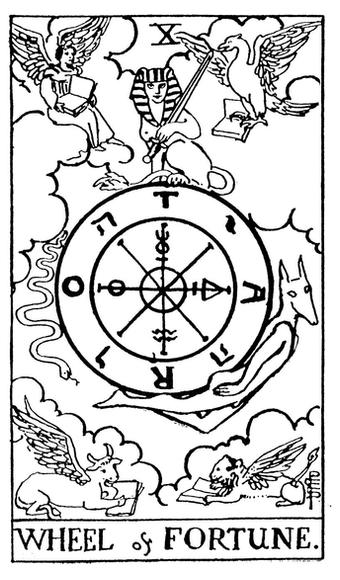The Wheel of Fortune. There is a current Manual of Cartomancy which has obtained a considerable vogue in England, and amidst a great scattermeal of curious things to no purpose has intersected a few serious subjects. In its last and largest edition it treats in one section of the Tarot; which— if I interpret the author rightly— it regards from beginning to end as the Wheel of Fortune, this expression being understood in my own sense. I have no objection to such an inclusive though conventional description; it obtains in all the worlds, and I wonder that it has not been adopted previously as the most appropriate name on the side of common fortune-telling. It is also the title of one of the Trumps Major— that indeed of our concern at the moment, as my sub-title shews. Of recent years this has suffered many fantastic presentations and one hypothetical reconstruction which is suggestive in its symbolism. The wheel has seven radii; in the eighteenth century the ascending and descending animals were really of nondescript character, one of them having a human head. At the summit was another monster with the body of an indeterminate beast, wings on shoulders and a crown on head. It carried two wands in its claws. These are replaced in the reconstruction by a Hermanubis rising with the wheel, a Sphinx couchant at the summit and a Typhon on the descending side. Here is another instance of an invention in support of a hypothesis; but if the latter be set aside the grouping is symbolically correct and can pass as such.
10
Major Arcana
The Fates/Destiny
Wheel of Fortune
You are caught in the ever-turning cycle of fate. Up, down, rise, fall—nothing stays the same forever. Will you fight it or flow with it?
Standard: Allowing events to unfold. Seeing the larger pattern in everyday events. Trusting your luck. Watching for cycles. Believing that "what goes around, comes around".
Reversed: Losing money gambling. Refusing to do your part to bring a plan to fruition. Taking a fatalistic approach to life. Fighting the natural course of events.
Questions to Ask
- How does this challenge fit into a larger pattern?
- What role does luck play in my circumstances?
- What can I control? How should I know when to relinquish control?
